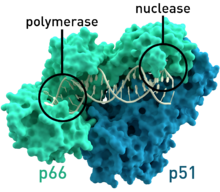Revers transkriptase
Revers transkriptase (RT) er et enzym, der transskriberer RNA til dobbeltstrenget DNA. Normal transskription er oversættelsen af DNA til RNA, deraf navnet "revers" (modsat). Enzymet kodes af retrovirus (f.eks. HIV) og retrotransposoner.
Retroviral RT har tre sekventielle biokemiske aktivititeter:
- RNA-afhængig DNA-polymerase,
- ribonuklease H og
- DNA-afhængig DNA-polymerase.
Se også
| Spire Denne molekylærbiologiartikel er en spire som bør udbygges. Du er velkommen til at hjælpe Wikipedia ved at udvide den. |
Medier brugt på denne side
Structure of the water molecule (H2O)
Forfatter/Opretter: Vektorgrafikken blev lavet med Inkscape. ., Licens: CC BY 3.0
Mechanism of reverse transcription in class VI virus ssRNA-RT, human immunodeficiency virus (HIV). Key: U3 - promoter region, U5 - recognition site for viral integrase; PBS - primer binding site; PP - polypurine section (polypurine tract); gag, pol, env - see HIV genome organisation). Colors mark complementary sequences. This diagram isn't drawn to scale.
Reverse transcription occurs in the cytoplasm of host cell. In this process, viral ssRNA is transcribed by the viral reverse transcriptase (RT) into double stranded DNA. Reverse transcription takes place in 5'→3' direction. tRNA ("cloverleaf") hybridizes to PBS and provides -OH group for initiation of reverse transcription. 1) Strong stop complementary DNA (cDNA) is formed. 2) Template in RNA:DNA hybrid is degraded by RNase H domain of reverse transcriptase 3) DNA:tRNA is transferred to the 3'-end of the template (synthesis "jumps"). 4) First strand synthesis takes place. 5) The rest of viral ssRNA is degraded by RNase H, except for PP site. 6) Synthesis of second strand of ssDNA is initiated from the 3'-end of the template. tRNA is necessary to synthesis of complementary PBS 7) tRNA is degraded 8) After another "jump", PBS from the second strand hybridizes with the complementary PBS on the first strand. 9) Synthesis of both strands is completed by the DNAP function of reverse transcriptase. Both dsDNA ends have U3-R-U5 sequences, so called long terminal repeat sequences (3'LTR and 5'LTR, respectively). LTRs mediate integration of the retroviral DNA into another region of the host genome. Sources: Alan Cann: Principles of molecular virology. Amsterdam: Elsevier Academic Press, 2005, p. 93 ISBN 0-12-088787-8.; en:Reverse transcription entry in Wikipedia.
Forfatter/Opretter: Thomas Splettstoesser (www.scistyle.com), Licens: CC BY-SA 3.0
Surface representation of the crystal structure of wild-type HIV-1 Reverse Transcriptase, based on PDB 3KLF. The active sites of polymerase and RNase are highlighted.




